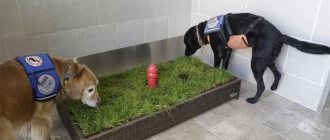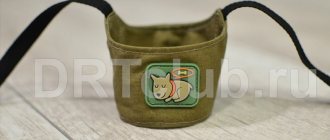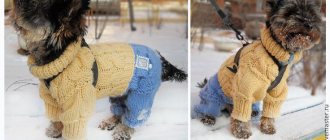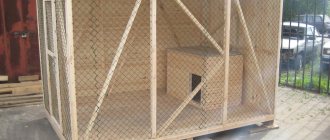Owners of four-legged pets who have problems walking their pets will sooner or later the noose collar comes to the rescue for dogs.
After all, many believe that this is a wonderful alternative to a traditional collar. In order to decide on this, you need to understand what choke collars and half-choke collars are for dogs.
Purpose of a leash-noose
Each pet has a different character. Some dogs are obedient, easily remember and follow all commands. However, many puppies and adult dogs are incredibly curious, and others may exhibit hunting traits. In this case, even a strong owner finds it quite difficult to keep the pet on a leash, especially if it is large.
The noose is used to train dogs
For such situations, a special device was invented and created - a choke collar. The device will not allow the animal to suddenly break away from its place, thanks to its specific design. After some time, the dog will form a reflex, and it will calmly walk on a leash, without tugging the owner in different directions.
Does training success depend on the dog's breed?
As a rule, all dogs are trainable, regardless of breed and size; differences can only be in the speed of mastering the command. Some breeds (retrievers, poodles, German shepherds, papillons, shelties, Dobermans and Rottweilers) learn faster, some (chow-chows, bulldogs, Afghan hounds) take longer, but it all depends on the owner, his readiness and efforts in training the pet.
Also, the speed of learning can be affected by the characteristics of the pet - dogs with high activity are less able to keep their attention on the task at hand.
Types of choke collars
Show ring for dogs: what is it and what is it for?
A choke collar for large dogs is a device with two restrictive rings instead of a clasp. To use, thread one ring into the other until it stops. Then the resulting loop is put on the dog over the head, and a leash is fastened to the free ring.
A choke leash helps teach a dog to move next to its owner.
Until the leash is pulled, the collar remains loose. When the animal twitches sharply, the leash is pulled, the noose begins to tighten, as a result of which the animal receives unpleasant sensations.
Important! This device is only allowed to be used on dogs over 5 months of age. The use of a noose on puppies and small breed dogs is not allowed to avoid injury.
There are also half-choke collars. The second name for such a device is martingale. Initially, this word was used to describe a special belt that prevented horses from throwing their heads back too far.
A half-choke is very similar to a noose, but a chain or leather strap is inserted into the rings, to which a leash is attached. The action of such a device is absolutely similar to a conventional noose. However, Martingale has certain positive aspects. When using a choke, the dog does not suffer as serious harm as can be caused by using a simple choke.
Training conditions
You should start training a dog only if it is in normal physical condition (not sick, not depressed and does not refuse food). It is better to feed the dog a couple of hours before, and take it for a walk just before practicing the commands, so that it does all the necessary things and slightly wastes energy, which will prevent absent-minded attention.
You should choose a secluded area for training - at the beginning of training, you do not want unnecessary noise and the presence of strangers, which the dog can be distracted by. It is better if it is a fairly spacious area in the fresh air that is familiar to the dog, with an even surface.
At first, it is better to avoid noisy places. Photo: Kate Hart
When the dog begins to make progress in mastering the command, you should slightly add distractions - change the training location or invite spectators. However, if the dog is very distracted, it is too early to leave the secluded training area.
What you need for training
To teach the “near” command, you will need a collar, a leash, treats for reward, and your favorite toy will also come in handy.
Training should be done daily for 15 minutes. If the dog is tired or distracted, it is best to stop training and continue the next day.
Which delicacy to choose
Treats for reward during training should be in the form of small pieces, not crumble and not get your hands dirty. You can only choose the most suitable treat for your dog through experience. These can be pieces of chicken, sausages, vegetables, fruits, cheese, dry food, and store-bought treats.
Industrially made treats for dogs
Some dogs willingly work for pieces of biscuits. The treat needs to be chosen so that it is desirable for your dog. It is better to choose several types of treats and alternate them periodically so that the dog does not get bored with them.
When to use a special collar
It is not always possible to teach a dog commands using ordinary techniques and equipment. If the dog is a fairly large breed, disobedient, hyperactive or aggressive, then a special collar can help you: a choke collar, a strict collar or an electronic collar.
All this ammunition requires knowledge of its practical use and special care in use.
Classification by material of manufacture
DIY dog collar: how to make it at home
There are various types of choke collars on sale. The main difference is what material it is made of. It is recommended to study all the features of different types before purchasing.
The collar must be selected strictly according to the size of the dog’s head.
Collars can be made from the following materials:
- Nylon. A dog noose made of this material is one of the most durable. The collar glides well, does not cling to rings, and is suitable for use in any weather. You are even allowed to swim in the ponds. Negative aspects include an increased risk of causing pain to the animal and the possibility of cuts on the owner’s hands.
- Leather. These collars are considered very beautiful and comfortable, perfect for pets with short hair. However, such nooses require special care and quickly lose their attractive appearance.
- Metal. Strict collars with spikes are often made from this material. When used, it can harm the coat and stain it, so it is not recommended to use the chain for dogs with light and long hair. It is better to use them for animals with short hairs.
There is also a noose leash with a lock for dogs on sale, made from combined materials. However, in any case, you should carefully inspect the device before purchasing.
What is a dog show ring?
To obtain the coveted victory at the exhibition, the correct choice of show ring plays an important role. And also important is the handler’s ability to control this accessory.
A ring leash on a dog. Such leashes are present in the list of products of almost every manufacturer of pet products; there are a very large number of them on sale.
Materials and design
Rings are made from different materials. The most popular are leather or nylon leashes . You need to fasten the leash behind the pet's ears, or open it wide and lie on the animal's back, on the chest, passing through the shoulder blades.
At their core, rings are a device in between a collar, a noose and a leash. They are manufactured in a wide variety of designs. There is also a fashion for the advantages of their appearance, color scheme and material. But the right to choose it always remains with the pet owner, regardless of fashion trends.
The ringovka is made from different materials.
Gallery of show rings
A show leash is a show leash.
You need to know how to use it.
There are a large number of varieties.
The leash is attached to the ears.
The ring is not noticeable on the dog.
You should select according to the color of the dog's coat.
Leash-noose at home
Strict collar for dogs: how to use
At home, you can easily make a leash-noose yourself. To do this you will need the following materials:
- nylon cord 4 meters,
- metal rings in the amount of 3 pieces,
- glue,
- synthetic threads,
- heat-shrink tubing.
Metal collars are recommended for dogs with short hair.
You can make a collar according to the following instructions:
- The cord is pulled through the ring, after which a braid is braided from it to the required length, leaving a small margin (the length is equal to the circumference of the pet’s neck).
- During braiding, the braid is carefully woven into the second ring, at the end it is threaded into this ring and fixed - the curved ends are connected behind the ring using a flame.
- It is recommended to treat the joint with glue and tie it with thread, just like the stop ring. If necessary, unsightly moments are covered with heat-shrink tubing.
Such a device, even though it is not entirely professional, can be easily used to train a dog.
Important! It is necessary to securely secure all the elements so that they do not come apart at the wrong time.
DIY half-choke collar
If you are terribly reluctant to go buy an expensive collar, but want to make it yourself, there is a simple recipe on how to make a wicker noose collar for a shepherd dog.
You won't need much:
- Nylon clothesline (two pieces, 1.8 m long, assuming that the dog’s neck is 60 cm in circumference)
- Two rings, possibly D-shaped (you can solder the carabiners)
- Glue
- Very strong nylon thread.
We pass the ropes through one ring (carabiner) and from it we begin to weave a braid (it turns out that it will consist of four flagella).
When we reach the required length (with a small margin), the excess needs to be cut off.
We thread the end of our braid into the second ring, bend it and singe it so that it is soldered, and wrap it tightly with nylon thread on top of the glue. If you are concerned about the strength, you can additionally rivet this area.
Advice! If you soak the collar, it will be much softer , but will not cease to be strong!
Training a puppy using a choke collar
When training a puppy, you need to use a noose very carefully, but in some cases you cannot do without it. With the help of a device, the animal can be distracted from various factors that interfere with learning. When used correctly, a choke collar cannot harm your pet. But its use will allow you to cope with the puppy’s disobedience and educate him.
For young dogs, the use of a choke is very similar to the training methods used by an adult mother dog. She will lightly choke the puppy until he yelps and feels discomfort.
For your information! Walking in a dog's noose follows approximately the following scenario: with any movement to the side, the dog will experience unpleasant sensations when the noose is tightened.
Possible errors and problems
When training, mistakes are possible, the admission of which complicates training or makes it incorrect.
- Jerk before the command is given. He knocks the dog down and doesn’t make it clear what they want from him.
- Driving a dog on a tight leash. Execution of the “nearby” command must be carried out on a loose leash, and subsequently without it, otherwise the dog will get used to the constant feeling of tension on the collar and will begin to consider this the norm.
- Giving a command with different intonation. The dog will not be able to remember all your intonations and associate them with a specific command, and a rude tone may even frighten him.
- Repeating the command when the dog walks nearby. If the dog follows a command, it should not be repeated again. This way, the pet can associate repeated issuance of a command with the norm and will carry it out only on a double command.
- The position of the dog when walking side by side is half a length forward/backward. This position of the dog makes it difficult for him to give other commands with a gesture, and also slows down the pet’s reaction to changing traffic conditions.
- Parallel study of different commands. It is difficult for an animal to learn several commands at once; it is worth practicing them one by one.
- Punishment for failure to follow commands. When teaching a dog commands, it is strictly not recommended to raise your voice or physically punish it. In this case, your pet’s training will be associated with negative emotions and will become ineffective.
Photo: Scott 97006
Photo: Virginia State Parks
Raising a dog is a labor-intensive process that requires patience and time, but the result can not only ensure its safety and save you stress, but also make your pet a well-deserved source of pride.
Features of training an adult dog to use a leash
It is more difficult to accustom adult dogs to a leash, because such dogs have already formed their character. Many experts agree that such an object in adulthood can cause quite serious stress in an animal. In this case, two scenarios are possible – active or passive resistance.
If there is active resistance, it is recommended to try to calm the dog down and distract his attention from the leash - after all, the more he jerks, the tighter the noose tightens. As soon as the dog calms down, you should encourage it and try to start the lesson. Gradually the animal will get used to it and understand the need to move next to its owner.
With sudden movements, the noose tightens, causing discomfort to the dog.
With a passive reaction, the dog can simply lie down and not move. In this case, attention will also help. Dog handlers recommend making small jerks and rewarding the dog for any display of activity. After some time, the pet will understand that using a noose does not cause much harm to it.
conclusions
It is worth remembering that the beauty of this accessory is certainly important, but its purpose is to restrain the dog. Therefore, pay more attention to the strength of materials and the quality of stitching. After all, an animal with a sudden movement can damage them and escape from your hands. If you doubt that the ring you made yourself will not be able to withstand the impulse of your pet, then purchase a leash in the store.
Show rings for dogs must be made of durable material.
How to properly walk a dog on a leash
Walking on a leash must be carried out in compliance with certain rules so that it does not cause inconvenience to either the animal or the owner.
First of all, you need to choose the right accessory. The choice of material from which it will be made depends on the preferences of the owner. The choice of size is carried out according to certain rules. The collar is worn over the dog's head, so its girth should be no less than the girth of the head at its largest point (ear area).
Important! An accessory that is too large requires more effort and stronger and longer jerks, while the effectiveness of the noose in this case decreases.
In addition, a large collar may fall off the dog or she will remove it herself. Therefore, the best length is considered to be head circumference plus 5 cm.
A choke leash is used only when training a pet. It is recommended to choose a quiet and calm place for training, where nothing will distract the dog.
The lesson process includes the following steps:
- The pet needs to be seated next to you. It is advisable that he already knows some commands, then the training will be easier.
- Next, start moving slowly, while the dog should be nearby, the leash should be loosened and sagging. As soon as the animal makes a jerk to the side, it is required to stop. At this moment the loop is tightened and the dog will feel discomfort.
- As soon as the pet returns to the starting place, the movement continues. The dog must clearly understand that it can only walk with its owner. With the next jerk, the owner stops, and the noose is triggered again. If the dog does everything right, then you definitely need to praise him.
During training, it is recommended to use the noose carefully so as not to harm the dog.
After some time, after several repetitions, the animal develops a clear reflex.
Dog handlers recommend using a noose only during classes, and abandoning this device during walks. There are several reasons:
- Such a collar can simply slip off the neck.
- When playing, it is possible that the pet may get caught on something and get injured.
- Injuries to other pets are possible when playing together.
- Chronic use often leads to addiction. As a result, the dog simply loses its conditioned reflex, and it does not react to the noose as required.
Strangleholds for dogs vary in material, size, appearance and even purpose. It is recommended to discuss the choice of item with your veterinarian. Such devices should not be used on small dogs and puppies to avoid possible injury. Dog handlers advise using the item only when necessary during training or at exhibitions, when you cannot do without it.
When purchasing, you need to carefully choose the size; you should keep in mind that both a large and a small noose leash will not fit and will only cause discomfort to your pet.
Do-it-yourself martingale collar
If the noose is too much for you, then we suggest making a half noose.
You will need:
- Raincoat
- Izolon or polyethylene foam
- Metal rings (can be D-shaped)
- Sling
- Optional, ribbon (for finishing)
We calculate the length of the collar - this is the circumference of the neck, minus the diameter of the ring. Add five to seven millimeters to the width of the sling and get the width of the collar.
We cut out a rectangle of the required size from the isolon, lay it on the raincoat fabric, add two centimeters to all sides, and cut it out again.
We cover the isolon with raincoat fabric.
We measure the sling 30 centimeters longer than the neck in circumference in order to firmly secure the rings.
Actually, we attach the sling to the collar blank, thread it through the rings and firmly sew the ends with a triple stitch on the machine.
Important! From one end we release the required length of the sling, pass this end through the second ring, then attach it to the side of the collar from which it comes. This is our control circuit.
The second ring can be secured in the middle of the control outline by stitching it with a cross stitch.
We remove the threads that were used to sweep away the sling with the workpiece and our martingale is ready.
Before using such collars, be sure to consult with a competent dog handler . He will give you detailed instructions and recommendations.











